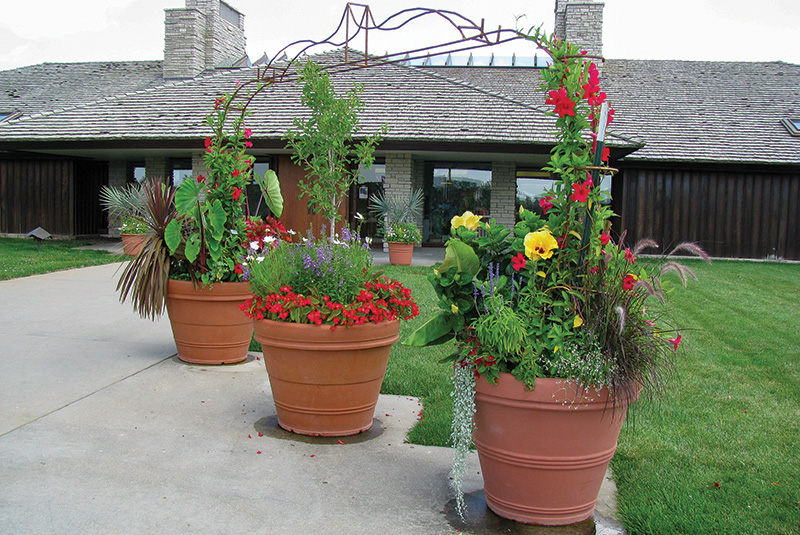
Well placed, high impact containers and flower beds are worth the investment for clubhouses. Photos by John Fech
Trees and shrubs do the heavy lifting on the golf course and are considered to be the meat and potatoes of the golfscape. Depending on the species and placement, non-woody plants can require moderate to high maintenance but also deliver high impact and amenity. To that end, containers, patio planters and flower beds are often used intentionally, but sparingly. Fortunately, there are many techniques to utilize that will deliver great results without breaking the budget.
Identify the theme
Thinking back to the course master plan is a great way to characterize the original intent of how containers and flower beds will be used. If it describes the use of these plants, then utilize it as a guide for selecting, installing and maintaining them. If not, then identify some “guardrails” or principles for how many the course will have and what they will look like.
Master plans usually go into great detail about establishing guidelines for consistency, improving the playing experience, and regular hole-by-hole analysis of the physical conditions of the course. Included with the tee, fairway, bunker, water hazard, irrigation system and greens review is a consideration of the woody and non-woody course plant material. Naturally, based on local input from the green committee, owner, professional, club manager and superintendent, varying degrees of emphasis are placed on softscape amenities. (Reference: Master Planning for Golf Courses, American Society of Golf Course Architects, 2006.)
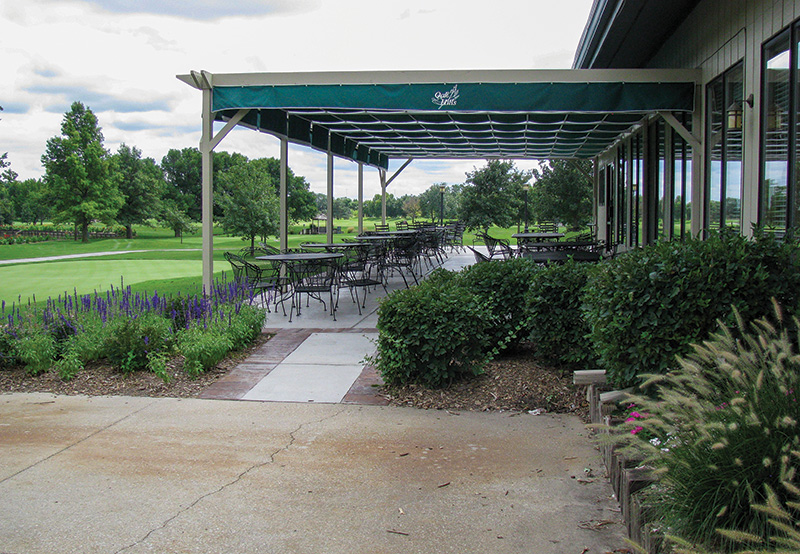
Flexible and practical pops of color are often appropriate for accenting practice greens.
Priority locations
Containers and flower beds can be used to meet needs — the need for color, accenting, softening harsh architectural lines and attracting attention to certain objects or views. To meet those needs, placing them in the right spot on the course is critical. If placed poorly, the identified needs are not met, and a lot of resources will be put into non-effective elements. If placed well, the opposite will occur, resulting in a positive return on investment. As such, it pays to identify high priority locations for containers and flower beds long before a shovel goes into the soil or a pot is filled with growing media.
Typical locations for effective usage
Generally, it’s wise to place containers and beds in high visibility locations where lots of members/golfers can see them to maximize their benefits. If you’re going to spend the money on their installation and maintenance, at least they should be seen and viewed often.
Clubhouses — In terms of prominence and frequency of views, the clubhouse is probably the most common interaction that golfers have with containers and flower beds. With all of the activity in this space, it makes good sense to focus a high degree of attention on plantings in this area. In addition to beauty, clubhouse plants can serve to solve architectural problems such as filling small spaces with suitable plant material, directing traffic to the appropriate hardscape paths, softening harsh lines, screening and separating large spaces into smaller ones when needed. If the budget is severely limited, the one logical location for investing resources is the clubhouse.
Practice greens — Next to the clubhouse, the practice green is a logical spot for non-woody plants. One key to success with practice green plantings is to keep them flexible in terms of making changes when needed. Permanent, difficult to alter installations can limit their effectiveness, while beds and planter placements that offer space definition and amenity with relative ease of changeouts are viable enhancements.
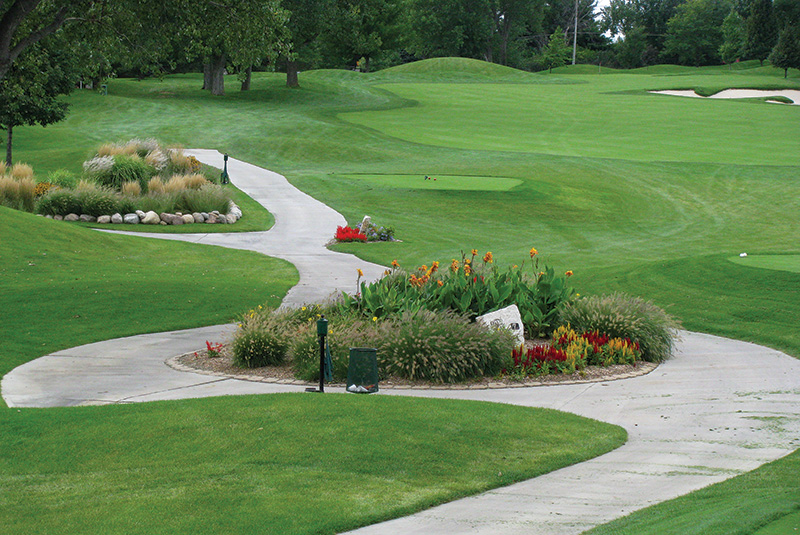
Plantings that highlight without distraction are valuable assets for tee boxes. Photo courtesy of Kim Erusha
Tee boxes — While tee boxes are another prominent location, beds and planters should be designed to enhance, not distract from a golfer’s first shot on the hole. This can easily be done by strategically placing them such that they can be viewed but not located closely enough to divert attention from focusing on swinging the golf club and striking the ball. Common examples include installing plants along a walkway to the tee and hanging baskets behind or adjacent to the tee.
Entrance markers — Depending on the desired emphasis, an entrance marker to a golf property can be an important location for enhancement. Well-placed and highly visible planters or beds can serve to beautify the space and highlight the direction of vehicle traffic to the parking lot, which is especially important for golfers who are new to the club and not familiar with the flow of traffic. Like other locations, entrance marker plants can be elaborate or simple but effective.
Refreshment stands — Like entrance marker plantings, refreshment stands and on-course restroom facilities can be planted without the concern of distracting golfers. An advantage of these locations is that water for plant hydration is usually available via tapping into the plumbing of the functional course feature.
Living signs — In some cases, a living sign – usually comprised of the initials of the course — can be strategically located for visual interest. During installation, it’s important to design these plantings with ease of watering and weed control in mind. Utilization of drip irrigation, preemergence herbicides and organic mulch goes a long way toward this goal.
Cart paths — Flower beds along cart paths are often prioritized lower on the list of needed items than others mentioned above, however, can be quite effective at directing traffic and defining golfscape spaces. Allowing adequate room for cart traffic is a must for these plantings.
Other — A site-specific category of containers, patio planters and other beds can feature the effective use of plant materials. For these plantings, it’s wise to rely heavily on the combined input of all golf stakeholders to ensure effective use. Bridges, passageways, maintenance sheds and pump houses often can be turned from eyesores into assets through the judicious use of containers and flower beds.
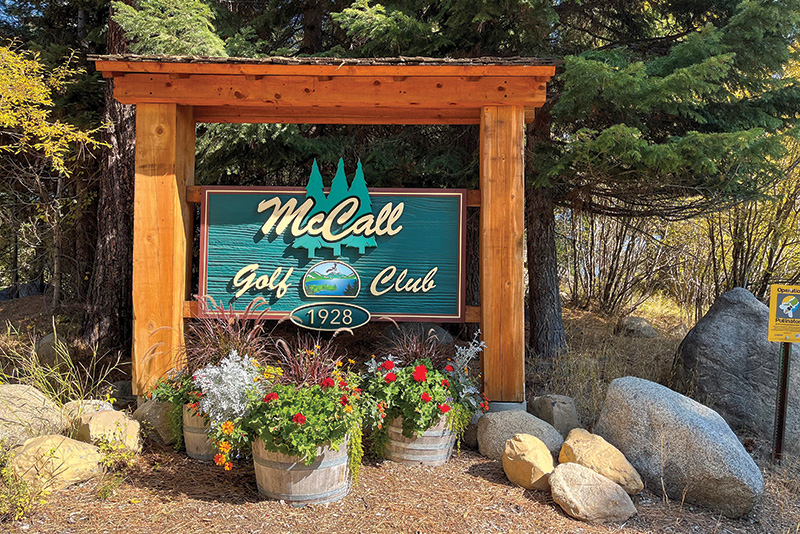
Highlighting the entrance to a golf course with color and texture is well worth the effort.
Methods for lessening maintenance requirements
In the overall scheme of golf course maintenance, utilizing pots and beds is most effective when best management practices for these plants are followed. The top 10 techniques follow:
KISS: Keep It Simple Sweetheart — Elaborate plantings are great if the budget and available staff allow for it, but many courses would be well served with a judicious number of simple, easy to maintain, effective ones. Like many things in life, the beauty of an effective ornamental feature is its simplicity.
Choose well — When designing or picking plants, the tried-and-true principle of “Right Plant, Right Place” (RPRP) applies. Perhaps the most important tenet of RPRP is sunlight exposure. As such, selecting all sun or all shade requiring species based on the sunlight exposure is paramount. Other important elements of RPRP are wind, soil moisture preference, slope and disease resistance.
Easy design formula — Again, there’s beauty in simplicity. One of the best is the original, the Thriller, Chiller, Spiller design (thank you Steve Silk) for containers, and the Front, Middle, Back approach for beds. A sweet spot of spacing applies to this technique as well, not too close, not too far apart for maximum appeal.
Keep it moist — For the vast majority of these types of plantings, moist, not soggy or dry roots will produce healthy, vibrant plants. When either extreme is the norm in terms of periodic watering, withered or rotten roots result. Regular monitoring of the root system moisture with a screwdriver is a simple but effective routine. Adjustable drip irrigation equipment can further ensure proper soil moisture.
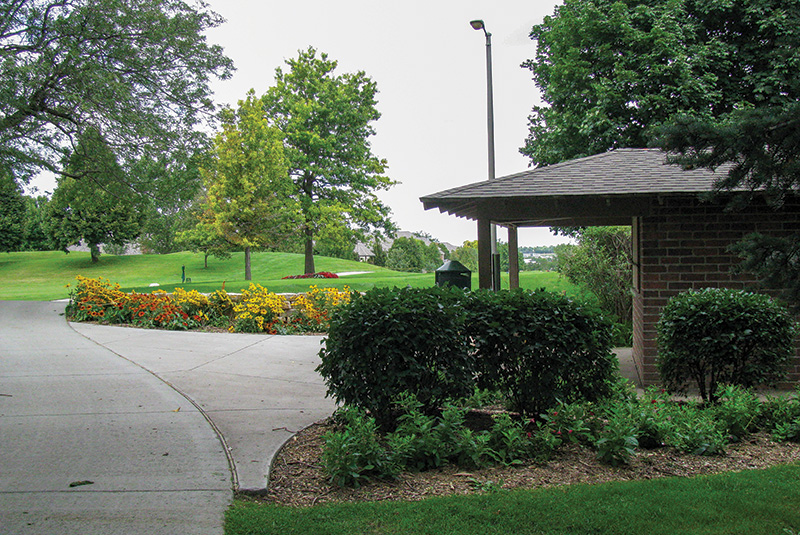
A few well-sited ornamentals near refreshment stands underscore the intent of the space.
Judicious fertilization — As with soil moisture, the not too much, not too little, just right approach is a good target to shoot for. The goal is to keep the plants vigorous but not produce excessive foliage at the expense of flowers. For most plants such as geraniums, pentas, petunias, coleus, periwinkle and impatiens, when too much nitrogen is applied, plentiful leaves are produced without much in the way of a floral display.
Separation of turf and ornamentals — In the design phase as well as during the maintenance season, keeping turf separated from beds is crucial to success. Avoiding “ornamental creep,” enlarging or reducing bed size only as an intentional change prevents damage from overwatering, mower damage and herbicide drift.
Mulching — Mulching serves three purposes in flower beds: to conserve water, to suppress weeds and, over time, to incorporate organic matter into the soil for future plantings. In some cases, mulches add desirable color and texture as well. To a lesser degree, mulches can be used in large containers for the same benefits. Pine needles, arborist wood chips and cocoa bean hulls are good options.
Container soils — Containers and patio planters perform best when a non-native soil media is utilized. Adequate drainage in pots is extremely important; in fact, the most common killer of a container plant is rotten roots from poor drainage. To encourage excessive water to drain from the pot, a mix of “drainers” such as sand, large bark chunks, perlite or vermiculite and “holders” including fine bark chunks/shavings, Canadian peat moss and compost is commonly used. A “2 drainers and 1 holder” formula is commonly used.
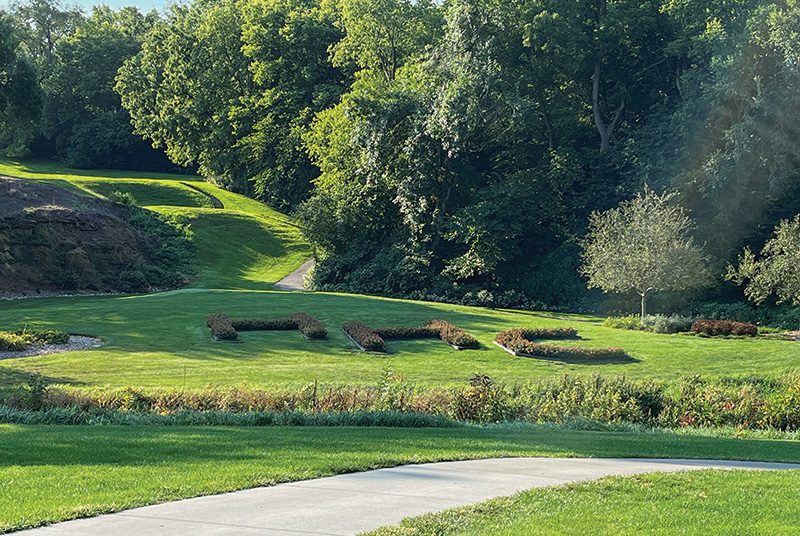
When well sited and designed, living signs are not difficult to care for.
Bed soils — The most influential factor with flower bed soils is the density. As a general rule, it’s best to adapt the particle size of the soil to the preference of the plants being grown. Loosening the soil to allow for root growth and crowning or sloping the grade to encourage excess water to move away are two common initial bed preparation steps. Amending with compost is another, as it has the potential to hold water in excessively well-drained soils or release it in ones that are excessively tight.
John C. Fech is a horticulturist and Extension educator with the University of Nebraska-Lincoln. He is a frequent and award-winning contributor to GCM.